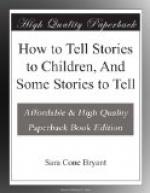INTRODUCTION
Not long ago, I chanced to open a magazine at a story of Italian life which dealt with a curious popular custom. It told of the love of the people for the performances of a strangely clad, periodically appearing old man who was a professional story-teller. This old man repeated whole cycles of myth and serials of popular history, holding his audience-chamber in whatever corner of the open court or square he happened upon, and always surrounded by an eager crowd of listeners. So great was the respect in which the story-teller was held, that any interruption was likely to be resented with violence.
As I read of the absorbed silence and the changing expressions of the crowd about the old man, I was suddenly reminded of a company of people I had recently seen. They were gathered in one of the parlours of a women’s college, and their serious young faces had, habitually, none of the childlike responsiveness of the Italian populace; they were suggestive, rather, of a daily experience which precluded over-much surprise or curiosity about anything. In the midst of the group stood a frail-looking woman with bright eyes. She was telling a story, a children’s story, about a good and a bad little mouse.
She had been asked to do that thing, for a purpose, and she did it, therefore. But it was easy to see from the expressions of the listeners how trivial a thing it seemed to them.
That was at first. But presently the room grew quieter; and yet quieter. The faces relaxed into amused smiles, sobered in unconscious sympathy, finally broke in ripples of mirth. The story-teller had come to her own.
The memory of the college girls listening to the mouse-story brought other memories with it. Many a swift composite view of faces passed before my mental vision, faces with the child’s look on them, yet not the faces of children. And of the occasions to which the faces belonged, those were most vivid which were earliest in my experience. For it was those early experiences which first made me realise the modern possibilities of the old, old art of telling stories.
It had become a part of my work, some years ago, to give English lectures on German literature. Many of the members of my class were unable to read in the original the works with which I dealt, and as these were modern works it was rarely possible to obtain translations. For this reason, I gradually formed the habit of telling the story of the drama or novel in question before passing to a detailed consideration of it. I enjoyed this part of the lesson exceedingly, but it was some time before I realised how much the larger part of the lesson it had become to the class. They used—and they were mature women—to wait for the story as if it were a sugarplum and they, children; and to grieve openly if it were omitted. Substitution of reading from a translation was greeted with precisely the same abatement of eagerness that a child shows when he has asked you to tell a story, and you offer, instead, to “read one from the pretty book.” And so general and constant were the tokens of enjoyment that there could ultimately be no doubt of the power which the mere story-telling exerted.




